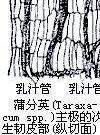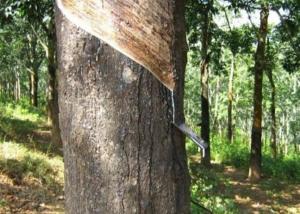乳汁管
概述
 植物体内含有乳汁的长管状结构,属于植物内部的分泌组织.由一个或一系列细长分枝的乳细胞形成.乳细胞是具有细胞质和多个细胞核的活细胞,液泡里含有大量乳汁.研究表明,巴西橡胶树的乳汁,存在于整个细胞质中并具粘滞性,常呈乳白色、黄色或橙色,主要成分为糖类、蛋白质、橡胶、树脂、生物碱、甙类、酶、鞣质、有机酸、挥发油等.乳汁管有贮藏和运输营养物质的机能.具乳汁管的植物很多,如蒲公英、莴苣、榕树、罂栗、番木瓜等.乳汁管可分为两类:(1)无节乳管,为一个分枝长达几米的乳细胞构成.如夹竹桃科、萝科、桑科和大戟属植物.具不分枝的乳管的如大麻.(2)有节乳管,由一系列管状乳细胞连接成为网状系统,连接处胞壁溶化贯通,如菊科、桔梗科、旋花科、芭蕉科以及大戟科的橡胶树属植物等.Milk plants contain a long tubular structure, belonging to the secretion of the internal organization of plants. By one or a series of slender branches of breast cells to form. Mammary cells is a cytoplasm and multiple nuclei of living cells, the vacuole contains a lot of milk inside. Research showed that the milk of Hevea brasiliensis, found in the cytoplasm, and a viscosity, Changcheng milky white, yellow or orange, the main component of carbohydrate, protein, rubber, resin, alkaloids, glycosides, enzymes, tannins, organic acid, volatile oil. milk possession of nutrient storage and transportation functions. a lot of the milk plant management, such as dandelion, lettuce, banyan, opium poppy, papaya and so on. milk tube can be divided into two categories: (1) No section of milk tube, to a branch a few meters long milk cells. such as the Apocynaceae, turnip Branch, Mr. Sankoh and Euphorbia spp. with no branches, such as marijuana milk tube. (2) of section milk tube, connected by a series of tubular breast cells to become mesh systems, connections linking cell wall dissolves, such as the Asteraceae, Campanulaceae, Convolvulaceae, Musaceae, and Euphorbiaceae species of rubber trees and so on.
植物体内含有乳汁的长管状结构,属于植物内部的分泌组织.由一个或一系列细长分枝的乳细胞形成.乳细胞是具有细胞质和多个细胞核的活细胞,液泡里含有大量乳汁.研究表明,巴西橡胶树的乳汁,存在于整个细胞质中并具粘滞性,常呈乳白色、黄色或橙色,主要成分为糖类、蛋白质、橡胶、树脂、生物碱、甙类、酶、鞣质、有机酸、挥发油等.乳汁管有贮藏和运输营养物质的机能.具乳汁管的植物很多,如蒲公英、莴苣、榕树、罂栗、番木瓜等.乳汁管可分为两类:(1)无节乳管,为一个分枝长达几米的乳细胞构成.如夹竹桃科、萝科、桑科和大戟属植物.具不分枝的乳管的如大麻.(2)有节乳管,由一系列管状乳细胞连接成为网状系统,连接处胞壁溶化贯通,如菊科、桔梗科、旋花科、芭蕉科以及大戟科的橡胶树属植物等.Milk plants contain a long tubular structure, belonging to the secretion of the internal organization of plants. By one or a series of slender branches of breast cells to form. Mammary cells is a cytoplasm and multiple nuclei of living cells, the vacuole contains a lot of milk inside. Research showed that the milk of Hevea brasiliensis, found in the cytoplasm, and a viscosity, Changcheng milky white, yellow or orange, the main component of carbohydrate, protein, rubber, resin, alkaloids, glycosides, enzymes, tannins, organic acid, volatile oil. milk possession of nutrient storage and transportation functions. a lot of the milk plant management, such as dandelion, lettuce, banyan, opium poppy, papaya and so on. milk tube can be divided into two categories: (1) No section of milk tube, to a branch a few meters long milk cells. such as the Apocynaceae, turnip Branch, Mr. Sankoh and Euphorbia spp. with no branches, such as marijuana milk tube. (2) of section milk tube, connected by a series of tubular breast cells to become mesh systems, connections linking cell wall dissolves, such as the Asteraceae, Campanulaceae, Convolvulaceae, Musaceae, and Euphorbiaceae species of rubber trees and so on.
附件列表
词条内容仅供参考,如果您需要解决具体问题
(尤其在法律、医学等领域),建议您咨询相关领域专业人士。

